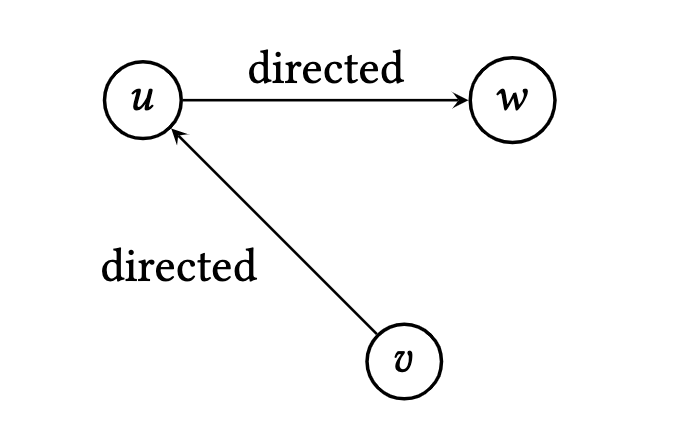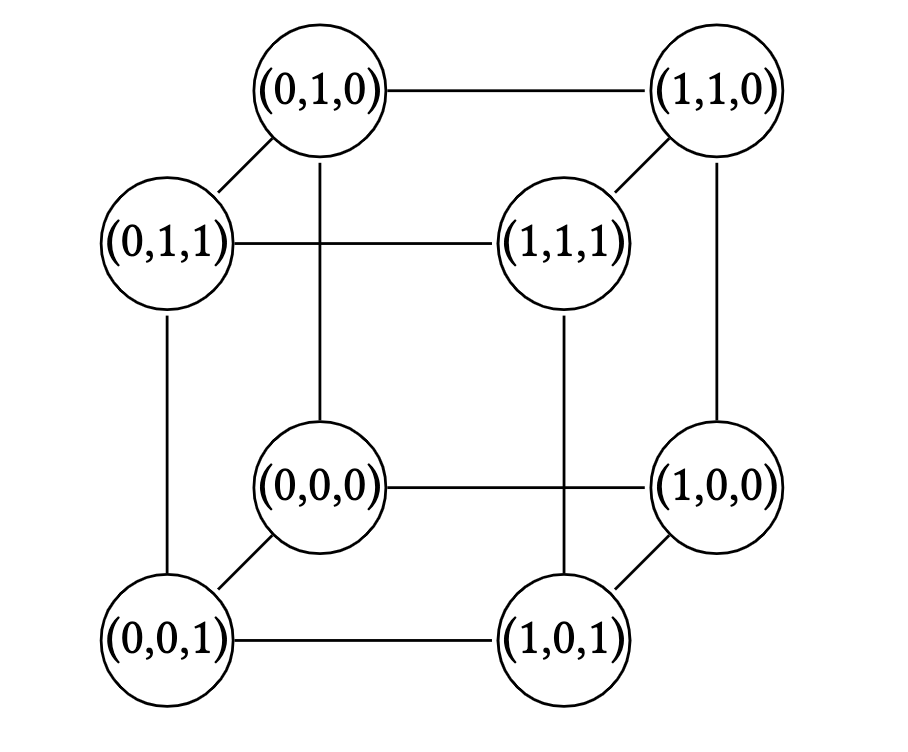Notes on Graph Theory (Updating...)
1 Basic counting: sets and tuples
This section lacks a formal definition of the cardinality of a set, offering instead an intuitive explanation of the concept (which refers to the number of elements within a given set). For certain audiences, this approach may be considered insufficiently rigourous. Nevertheless, this is enough for our purpose.
If $X$ is a set, then $|X|$ is the size or cardinality of $X$. Most of the sets we will encounter in this note will be finite (with the frequent exception of the natural numbers $\mathbb{N}=\{1,2,3, \ldots\}$ ).
Our canonical set of size $n$ (where $n \in \mathbb{N}$ ) is denoted by $[n]:=\{1,2, \ldots, n\}.$
The empty set is denoted $\emptyset$.
If $A$ and $B$ are sets, then $A$ is a subset of $B$ if every element of $A$ is also an element of $B$. We denote this by $A \subseteq B$.
If $A$ and $B$ are sets, then their union is $A \cup B=\{x \mid x \in A \text{ or } x \in B\}$ and their intersection is $A \cap B=\{x \mid x \in A \text{ and } x \in B\}$.
The set difference of $A$ and $B$ is $A \backslash B=\{x \mid x \in A \text{ and } x \notin B\}$. The symmetric difference of $A$ and $B$ is $A \Delta B=(A \backslash B) \cup(B \backslash A)=(A \cup B) \backslash(A \cap B).$
If $A$ and $B$ are sets, then their cartesian product is $A \times B=\{(a, b) \mid a \in A \text{ and } b \in B\}$.
If $A$ and $B$ are sets such that $A \cap B=\emptyset$, then we say $A$ and $B$ are disjoint. If we have a union of two disjoint sets, we emphasize this by writing $A \dot{\cup} B$. If $A_1, A_2, \ldots, A_n$ are sets, then we say they are pairwise disjoint if $A_i \cap A_j=\emptyset$ for all $1 \leq i<j \leq n$.
Let $A$ and $B$ be finite sets. Then
- $|A \setminus B|=|A|-|A \cap B|;$
- $|A \cup B|=|A|+|B|-|A \cap B|;$
- $|A \times B|=|A| \cdot|B|;$
- If $A_1, A_2, \ldots, A_n$ are pairwise disjoint sets, then $\left|\bigcup_{i=1}^n A_i\right|=\sum_{i=1}^n\left|A_i\right|;$
- If $A_1, A_2, \ldots, A_n$ are sets, then $\left|\bigcup_{i=1}^n A_i\right| \leq \sum_{i=1}^n\left|A_i\right|.$
Proof. Omitted. ◻
The so-called sum rule holds for disjoint sets: if $A$ and $B$ are disjoint sets, then $|A \cup B|=|A|+|B|$. This follows from Lemma 1.1 (2).
For any integer $k \geq 1$, we define $k$ factorial to be $k !=k(k-1) \cdots 2 \cdot 1$. We define $0 !=1$. For integers $n \geq k \geq 1$, we define the $k$-th falling factorial of $n$ by $(n)_k=$ $n(n-1) \cdots(n-k+1)$. So $(k)_k=k !$.
Let $X$ be a set. A $k$-tuple of elements from $X$ is $\left(x_1, x_2, \ldots, x_k\right)$ where $x_i \in X$ for $1 \leq i \leq k$. Note that the elements of a $k$-tuple need not be distinct. We will denote the set of $k$-tuples from $X$ by $X^k$.
Let $X$ be a set. A $k$-tuple of distinct elements from $X$ is $\left(x_1, x_2, \ldots, x_k\right)$ where $x_i \in X$ for $1 \leq i \leq k$ and $x_i \neq x_j$ for $i \neq j$. We will denote the set of $k$-tuples of distinct elements from $X$ by $(X)_k$.
If $X$ is a set of size $n$ and $0 \leq k \leq n$, then the family of $k$-sets from $X$ is \({X \choose k} =\{A \subseteq X: | A| =k\} .\)
Let $0 \leq k \leq n$ be integers. Recalling that $0!=1$ and we define the binomial coefficient by \({n \choose k}=\frac{n !}{k !(n-k) !}=\frac{(n)_k}{k !} .\)
If $X$ is a set, then the power set of $X$ is the family of all subsets of $X$ : \(\mathscr{P}(X)=\{A \mid A \subseteq X\} .\)
Often we work with subsets of a given "universal set" $X$. In this case we can define the complement of a set $A \subseteq X$ by $A^c=X \backslash A$.
Let $1 \leq k \leq n$ be integers and $X$ be a set of size $n$. Then
There are $n^k$ different $k$-tuples of elements from $X$, so $\left|X^k\right|=n^k$;
There are $n(n-1) \cdots(n-k+1)$ different $k$-tuples of distinct elements from $X$, so $\left|(X)_k\right|=(n)_k$;
There are $n!$ distinct permutations of the elements of $X$;
There are ${n \choose k}$ distinct $k$-sets from $X$, so $\left|{X \choose k}\right|={n \choose k}$;
${n \choose k}={n \choose n- k}$;
${n+1 \choose k}={n \choose k}+{n \choose k-1}$;
$|\mathscr{P}(X)|=2^n$.
Proof. Omitted. ◻
2 Graphs
2.1 Basic definitions
A graph is a pair $(V, E)$ of sets with $E \subseteq {V \choose 2}$. An element of $V$ is a vertex and an element of $E$ is an edge. We denote the set of vertices and the set of edges of a graph $G$ by $V(G)$ and $E(G)$ respectively. The order of a graph $G$ is the number of vertices $|V(G)|$. The size of a graph is the number of edges $|E(G)|$.
If $G$ is a graph and $v \in V(G)$, then the neighbourhood (or $n b h d$) of $v$ is the set \(\Gamma(v)=\{u \in V(G) \mid u v \in E(G)\} .\) The degree of a vertex $v \in V$ is the size of its neighbourhood: $d(v)=|\Gamma(v)|$.
Beware of other different definitions of graphs! All the graphs in this note will be simple, loopless, and undirected. To be precise, a graph is simple if it cannot have multiple edges between two vertices; a graph is loopless if every edge contains exactly two different vertices; a graph is undirected if its edges are 2-sets such as ${u, v}$ rather than ordered pairs such as $(u, v)$ or $(v, u)$. Note that our definition of a graph as $G=(V, E)$ with $E \subseteq {V \choose 2}$ implies immediately that they are simple, loopless and undirected.
 Figure 2. An undirected graph which is not loopless and not simple
Figure 2. An undirected graph which is not loopless and not simple
If $e=\{u, v\}$ is an edge in a graph $G$, with a slight abuse of notation, we will often write this as $e=u v$. Note that this does not imply that the edge has a direction as our graphs are undirected.
If $e=u v$ is an edge, then $e$ is incident to $u$ and $v$.
A graph $G$ is $r$-regular if $d(v)=r$ for all $v \in V(G)$.
The degree sequence of a graph $G = (V, E)$ is the tuple $\left(d\left(v_1\right), d\left(v_2\right), \ldots, d\left(v_n\right)\right),$ where $V=\left\{v_1, \ldots, v_n\right\}$ and $d\left(v_1\right) \leq d\left(v_2\right) \leq \cdots \leq d\left(v_n\right)$.
For any graph $G=(V, E)$, one has \(\sum_{v \in V} d(v)=2|E|.\)
Proof. Omitted. ◻
In any graph, the number of vertices of odd degree is even.
Proof. Omitted. ◻
2.2 Examples of graphs
Recall that for $n \in \mathbb{N}$, we define $[n]=\{1,2, \ldots, n\}$.
$K_n$ is the complete graph of order $n \geq 1$ where
\[V\left(K_n\right)=[n], \quad E\left(K_n\right)= {[n] \choose 2}.\]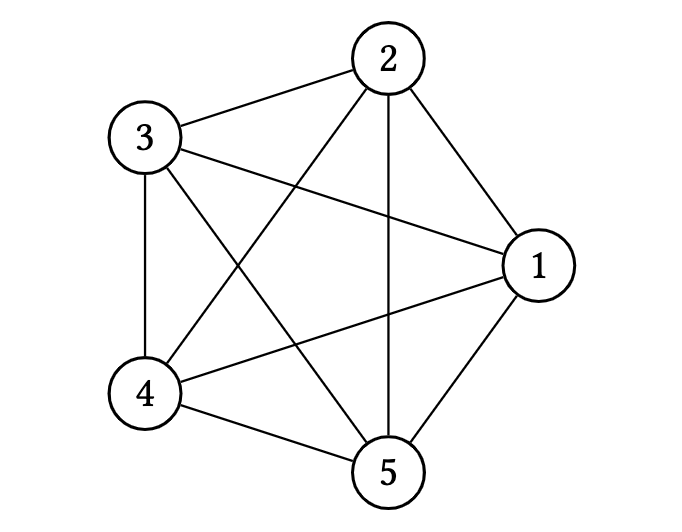 Figure 3. The complete graph of order $5$, $K_5$
Figure 3. The complete graph of order $5$, $K_5$
$E_n$ is the empty graph of order $n \geq 1$ where
\[V\left(E_n \right)=[n], \quad E\left(E_n \right)=\emptyset.\] Figure 4. The empty graph of order 3, $E_3$
Figure 4. The empty graph of order 3, $E_3$
$C_n$ is the cycle of length $n \geq 3$ where
\[V\left(C_n\right)=[n], \quad E\left(C_n\right)=\{\{i, i+1\} \mid i=1,2, \ldots, n-1\} \cup\{\{1, n\}\}.\]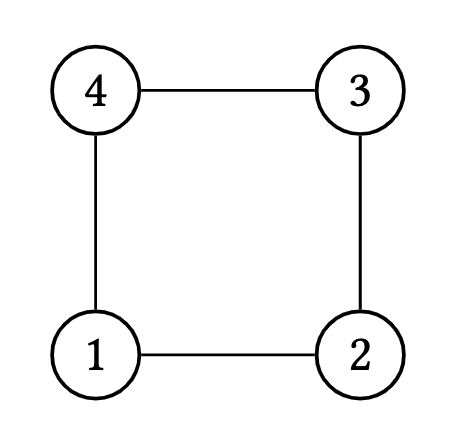 Figure 5. The cycle of order 4, $C_4$
Figure 5. The cycle of order 4, $C_4$
$P_n$ is the path of length $n \geq 1$ (with $n$ edges and $n+1$ vertices) where
\[V\left(P_n\right)=\{0,1,2, \ldots, n\}, \quad E\left(P_n\right)=\{\{i-1, i\} \mid i \in[n]\}.\]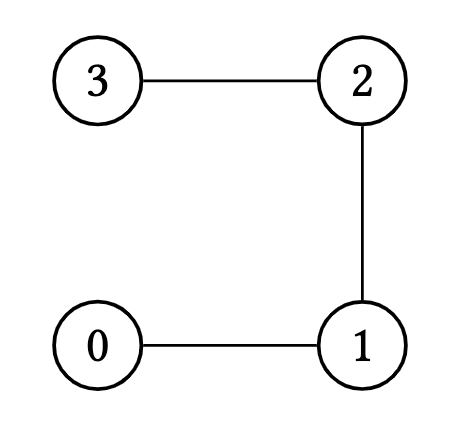 Figure 6. The path of length 4, $P_4$
Figure 6. The path of length 4, $P_4$
$K_{a, b}$ is the complete bipartite graph with classes of size $a$ and $b$ $(a, b \geq 1)$ where
\[\begin{aligned} V\left(K_{a, b}\right)&=\{1,2, \ldots, a\} \dot{\cup}\{a+1, a+2, \ldots, a+b\}, \\ E\left(K_{a, b}\right)&=\{\{i, j\} \mid 1 \leq i \leq a, a+1 \leq j \leq a+b\} . \end{aligned}\]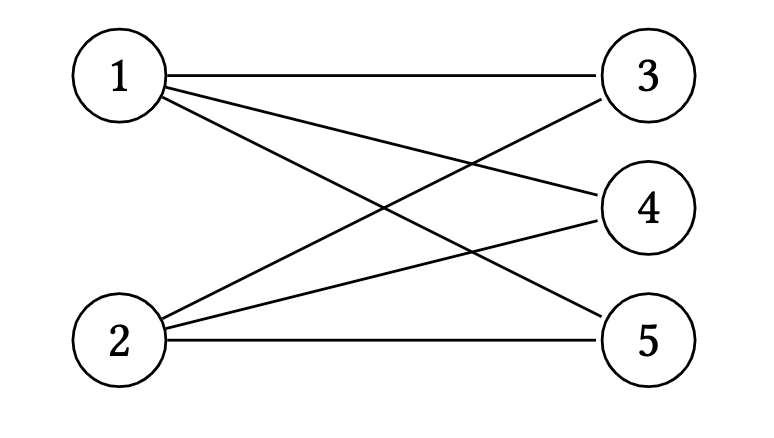 Figure 7. The complete bipartite graph with classes of size 2 and 3
Figure 7. The complete bipartite graph with classes of size 2 and 3
$Q_n$ is the discrete hypercube of dimension $n \geq 1$ where
\[V\left(Q_n\right)=\{0,1\}^n, \quad E\left(Q_n\right)=\{x y \mid x \text{ and } y \text{ differ in exactly one coordinate} \}.\]